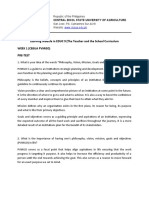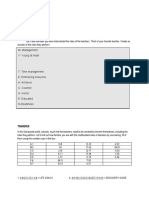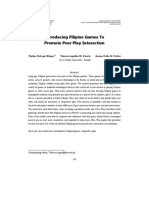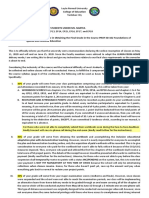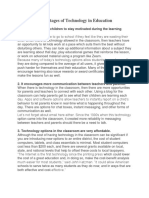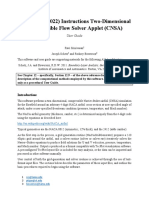Advantage and Disadvantage of Technology in Education
Advantage and Disadvantage of Technology in Education
Uploaded by
rickCopyright:
Available Formats
Advantage and Disadvantage of Technology in Education
Advantage and Disadvantage of Technology in Education
Uploaded by
rickOriginal Description:
Original Title
Copyright
Available Formats
Share this document
Did you find this document useful?
Is this content inappropriate?
Copyright:
Available Formats
Advantage and Disadvantage of Technology in Education
Advantage and Disadvantage of Technology in Education
Uploaded by
rickCopyright:
Available Formats
Advantage and Disadvantage of technology in education
Technological advancements have made the world a great and convenient place to live in. There is no denying
of how they make lives better and easier, especially in the fields of science, medicine and education. But like
most things, technology also has its drawbacks. In fact, some of the more recent inventions are now being
categorized as lazy aids, and are considered major contributors of obesity and a generally unhealthy
population.
5 examples of the advantages of technology Education
1. Promotes Independent learning in students.
-The internet is a treasure trove of information. Practically anything you need to know can be found
online. Although there is a question of the credibility of the source and the data provided, it can still
serve as an educational resource for students. Even without assistance from parents and teachers,
students can just look up their lessons online.
2. Prepares students for the future.
-From the way technological advancements are going, it is obvious that the future will be digital and
technology focused. If students are well-versed on using technology to collaborate and
communicate as early as now, they will not have trouble fitting in, competing and finding jobs in the
future. Being familiar with using at least one form of technology at an early age will help them
become comfortable using it, and eventually develop other skills necessary to handle other
innovative devices and processes.
3. Has the potential to lower textbook and tuition prices.
-With resources more accessible and in great abundance, the cost of textbooks is likely to
decrease. It is also possible that students may no longer need to buy a textbook, if it is converted
into digital format. The actual books can stay in the classroom, while the content is saved on a
student’s computer.
Tuition will also decrease when learning is done online, rather than inside the classroom. By taking
out the factors that contribute to a higher tuition fee, such as utility bills and transportation
allowance of teachers, the overall cost of education will be lower.
4. Allows teachers to create an exciting way to educate students.
-Gone are days when the only tools for teaching are limited to books, a blackboard or whiteboard,
and a chalk or markers. With technology integrated to education, teachers can now incorporate
images, videos and other graphics when delivering lessons. Specific websites, apps and programs
will also enable teachers to vary how they provide instructions. This creates an exciting learning
environment and promotes interest in education in general.
5. Encourages development of new teaching methods.
-Rather than spend an hour or so talking while the students listen, or have them read an entire
chapter in silence, teachers and professors now have the option to use advance teaching methods,
such as podcasts, blogs and social media. When working with a particular group or one-on-one,
teachers can take advantage of web conferencing technologies other online communication tools.
Technology also presents universal tools that enable teachers to educate all types of students,
including those who are struggling or have special needs. These include voice recognition, text-to-
speech converter, translator, volume control, word prediction software and other assistive
technologies.
5 Examples of the Disadvantages of technology in Education
1. Results in lack of interest in Studying
-Because everything is now accessible online or through data saved in a computer or mobile devices,
students are likely to develop poor studying habits and a lazy attitude towards education. Some of them
may even think they can skip school because they can find answers and lessons online. Who needs
teacher when you have internet and Google, right?
This can also lead to students forgetting the basics of studying. They would rather rely on computer and
the internet, instead of their books and the input from their teachers. Most of them will misspell words
because they often use spell checkers. Rather than solve mathematical equations the traditional way,
they would seek assistance from computers or look for the answers directly through search engines.
When it is time to take the tests in the classroom and without any form of technology, students are likely
to fail.
2. Make students vulnerable to potential pitfall
-While computers prove to be an invaluable educational tool, it can also be a source of problems. This
is especially true for students who lack the skills needed to maximize a device’s functionalities.
Technical problems and computer malfunctions can cause loss of assignments and other materials,
resulting in high levels of stress that students. Add to this other things that they will discover online,
which are completely unrelated to school and education, and they will be distracted to no end.
3. Negative views on technology
-Consumerism has taught us that technologies, from computers to mobile devices, are widely viewed
as tools for learning. So, between a tablet and a textbook, students are likely to gravitate towards
learning when reading a book, while they are likely to use a tablet to play games or spent time on social
media.
4. Raise instructional challenges
-For professors and teachers to stay abreast with technology, they may need to be retrained. Those
who have been teaching all their lives using traditional methods may not be very susceptible to the
changes being applied. They may even see it as threat to their job security and shun technology
altogether. In fact, a majority of teachers believe that constant use of digital technology is affecting a
student’s attention span and his ability to persevere when a challenging task is thrown his way.
Although such belief is subjective, scholars, experts and teachers all agree that technology has
changed the way students learn.
5. Can diminish overall value of in-person education
-Although research on online learning did not establish a direct link to how personal interaction affects a
student’s performance, data gathered did show that those who enrolled in online courses have higher
chances of failing, dropping out of classes, and are less likely to benefit from them. This may have
something to do with the fact that lessons delivered online or through digital resources lack the face-to-
face interaction between teacher and student that provides a more personal experience.
CONCLUSION:
Integrating technology in education has its advantages and disadvantages, but proper implementation
might help keep the drawbacks to a minimum. Better planning is necessary.
@ 2019 GREENGARAGEBLOG.ORG – PRIVACE POLICY
You might also like
- Qualys AnswersDocument7 pagesQualys AnswersMunaam TariqNo ratings yet
- Diagrama ECU 2018 Ford Fiesta L4-1.6LDocument4 pagesDiagrama ECU 2018 Ford Fiesta L4-1.6LGerardo Sinco Masharely100% (1)
- Chapter 1: Concepts About Educational TechnologyDocument14 pagesChapter 1: Concepts About Educational TechnologyGarhole TzyNo ratings yet
- 10 Top Advantages and Disadvantages of Technology in EducationDocument10 pages10 Top Advantages and Disadvantages of Technology in EducationEe Lynkh100% (2)
- Radio Shack Pro 2026 Scanner ManualDocument3 pagesRadio Shack Pro 2026 Scanner ManualMarcos GuerreroNo ratings yet
- Id ProDocument50 pagesId PromohamedNo ratings yet
- Rojo Final Thesis - Chapter 1-5Document39 pagesRojo Final Thesis - Chapter 1-5Criselda Cabangon DavidNo ratings yet
- Middle Childhood (The Primary Schooler) : Name: Sudani Bhavika NarshibhaiDocument25 pagesMiddle Childhood (The Primary Schooler) : Name: Sudani Bhavika Narshibhai216 SUDANI BHAVIKA NARSHIBHAINo ratings yet
- Tolman'S Purposive BehaviorismDocument7 pagesTolman'S Purposive Behaviorismmarjory albertoNo ratings yet
- FiyndatioDocument7 pagesFiyndatioDansoy Alcantara MiguelNo ratings yet
- Garcia, Angelica LOTUS ACCOMPLISHMENT REPORT FOR NOVEMBERDocument6 pagesGarcia, Angelica LOTUS ACCOMPLISHMENT REPORT FOR NOVEMBERGelica GieNo ratings yet
- Ethics in All and Climes 4Document10 pagesEthics in All and Climes 4carol navaretteNo ratings yet
- Final Notes PE2Document5 pagesFinal Notes PE2israel seraficaNo ratings yet
- Secondary Education Improvement and Development Program (SEDP) IDocument7 pagesSecondary Education Improvement and Development Program (SEDP) IRodalyn T. LopezNo ratings yet
- A Policy Proposal For Educational Support Among Secondary Students in Barangay PagaspasDocument89 pagesA Policy Proposal For Educational Support Among Secondary Students in Barangay PagaspasJerome UnicoNo ratings yet
- Various Laws Affecting Teachers and SchoolsDocument3 pagesVarious Laws Affecting Teachers and SchoolsMLG F100% (1)
- Weaknesses of Filipino CharacterDocument13 pagesWeaknesses of Filipino CharacterMary Ro Se LampasNo ratings yet
- Issues and Trends in Teaching 21st Century LiteraciesDocument19 pagesIssues and Trends in Teaching 21st Century LiteraciesGracielle ValdezNo ratings yet
- SSE 101 HANDOUTS 1 Themes of Social StudiesDocument2 pagesSSE 101 HANDOUTS 1 Themes of Social StudiesJessa Marie ManaloNo ratings yet
- Yap Global Filipino in Multilingual Education PDFDocument21 pagesYap Global Filipino in Multilingual Education PDFJeslie Del Ayre LuzaNo ratings yet
- School Master List FormatDocument2 pagesSchool Master List FormatChristopher PantojaNo ratings yet
- Tarlac State University: College of Teacher EducationDocument12 pagesTarlac State University: College of Teacher EducationSOFIA GUTIERREZNo ratings yet
- WEEK 1-Pre and Post TestDocument2 pagesWEEK 1-Pre and Post TestFrancia LacruaNo ratings yet
- M-Management Y - Young at HeartDocument8 pagesM-Management Y - Young at HeartKieth InlabNo ratings yet
- Introducing Filipino Games To Promote Peer Play InteractionDocument21 pagesIntroducing Filipino Games To Promote Peer Play InteractionAlexandra SolenNo ratings yet
- Name Module No: - 7 - Module Title: Learners With Difficulty Hearing Course and Section: BSED-3A - Major: Social ScienceDocument5 pagesName Module No: - 7 - Module Title: Learners With Difficulty Hearing Course and Section: BSED-3A - Major: Social ScienceChristine Joy Marcel100% (1)
- PROF ED 102 Course NotesDocument15 pagesPROF ED 102 Course NotesKaren Roldan RosalejosNo ratings yet
- Multicultural and Global Literacy PDFDocument4 pagesMulticultural and Global Literacy PDFJunna Treschia GUIMARY0% (2)
- 10 Challenges of TeachingDocument8 pages10 Challenges of TeachingJEVELYN LIBRES100% (1)
- New Curriculum BSEC English PHDocument1 pageNew Curriculum BSEC English PHMadelle Dela CruzNo ratings yet
- Philippine K 12 Trends IssuesDocument16 pagesPhilippine K 12 Trends IssuesJuniser Oliva100% (1)
- Field Study 2-Matrix of ActivitiesDocument2 pagesField Study 2-Matrix of ActivitiesJezzel ReponteNo ratings yet
- The Teacher and School The Curriculum: Prepared byDocument8 pagesThe Teacher and School The Curriculum: Prepared byBES BEBENo ratings yet
- Teacher Level FactorsDocument12 pagesTeacher Level FactorsMiner Casañada Piedad0% (1)
- Famacion - Task 2 Cultural Mapping For Movable HeritageDocument2 pagesFamacion - Task 2 Cultural Mapping For Movable HeritageKyra Bianca R. FamacionNo ratings yet
- DepEd Promoting English As Medium of InstructionDocument4 pagesDepEd Promoting English As Medium of InstructionJames Patrick Olivar0% (1)
- Teachers Heart in Conquering Separation Anxiety of Kindergarten StudentsFEROLINO and BUQUIRAN ARTICLE 1Document8 pagesTeachers Heart in Conquering Separation Anxiety of Kindergarten StudentsFEROLINO and BUQUIRAN ARTICLE 1Christine Gornez VillacampaNo ratings yet
- Basic Education Curriculum ReformsDocument15 pagesBasic Education Curriculum ReformsJuju GarlanNo ratings yet
- Classroom StructuringDocument1 pageClassroom StructuringvanessaresullarNo ratings yet
- The Myth About The Lanzones FruitDocument5 pagesThe Myth About The Lanzones FruitChelleVilla100% (1)
- Health CG PDFDocument92 pagesHealth CG PDFRon April Custodio Frias100% (1)
- Secondary Education Development ProgramDocument8 pagesSecondary Education Development ProgramBrose CathieNo ratings yet
- Carbon Oxygen CycleDocument3 pagesCarbon Oxygen CycleRommel Villaroman EstevesNo ratings yet
- Buwan Buwan ReportDocument5 pagesBuwan Buwan ReportArjay DomisiwNo ratings yet
- Narrative Report: John Lambert Doronela James Joseph GalosDocument5 pagesNarrative Report: John Lambert Doronela James Joseph GalosSylvia-Chan SylveonNo ratings yet
- Structures of Facilitating Learner-Centered TeachingDocument12 pagesStructures of Facilitating Learner-Centered TeachingLovely MarasiganNo ratings yet
- Travails of Out-of-Field-Teaching Qualitative InquiryDocument22 pagesTravails of Out-of-Field-Teaching Qualitative InquiryFrancis Edward BlancoNo ratings yet
- Productivity Software ApplicationsDocument2 pagesProductivity Software ApplicationsAngel MoralesNo ratings yet
- Lesson 10 MODULE-pages-72-81-1Document10 pagesLesson 10 MODULE-pages-72-81-1Cedie Aviles SeraficaNo ratings yet
- HISTORY OF EARLY CHILDHOOD EDUCATION ResearchDocument12 pagesHISTORY OF EARLY CHILDHOOD EDUCATION ResearchJivi Plameras100% (1)
- Chapter II - The Teacher in The Classroom and CommunityDocument43 pagesChapter II - The Teacher in The Classroom and CommunityLes SircNo ratings yet
- BIGNO PE 2-ImpressionDocument9 pagesBIGNO PE 2-ImpressionBiel AbistadoNo ratings yet
- Module 1 Curriculum IntegrationDocument9 pagesModule 1 Curriculum IntegrationRexonChanNo ratings yet
- CAUSE AND EFFECT of TEACHERS EXCHANGE PROGRAMDocument1 pageCAUSE AND EFFECT of TEACHERS EXCHANGE PROGRAMAubrey Paborian0% (1)
- Bicol RegionDocument3 pagesBicol RegionAnonymous OtT7UL7100% (1)
- Thesis - KalangananDocument76 pagesThesis - KalangananDonna Grace TanggeNo ratings yet
- Research 1Document5 pagesResearch 1Vince Joshua Aquino CaturaNo ratings yet
- PROFED8 - Activity 1Document1 pagePROFED8 - Activity 1Montenegro Roi VincentNo ratings yet
- Batas Pambansa Blg. 232 PDFDocument25 pagesBatas Pambansa Blg. 232 PDFNorman Serna100% (4)
- Perceptions of Elementary Grade Teachers On The Effectiveness of Maguindanaon Tongue Based Textbooks in Selected Schools of North CotabatoDocument33 pagesPerceptions of Elementary Grade Teachers On The Effectiveness of Maguindanaon Tongue Based Textbooks in Selected Schools of North CotabatoMakaldsaMacolJr.No ratings yet
- Chapter 5 Lesson 2 The Teaching Profession in The ASEAN and BeyondDocument6 pagesChapter 5 Lesson 2 The Teaching Profession in The ASEAN and BeyondKC Mae A. Acobo - CoEdNo ratings yet
- Sorsogon State College: Republic of The PhilippinesDocument2 pagesSorsogon State College: Republic of The PhilippinesJhon Dave SurbanoNo ratings yet
- Technology of EducationDocument7 pagesTechnology of EducationJohn Perseus LeeNo ratings yet
- Legend: Vicinity MapDocument1 pageLegend: Vicinity MaprickNo ratings yet
- Structural Analysis and Design Report: Copra Consolidation and TradingDocument37 pagesStructural Analysis and Design Report: Copra Consolidation and TradingrickNo ratings yet
- Water Pipe Line Layout Plan: Private Room Private Room Private RoomDocument1 pageWater Pipe Line Layout Plan: Private Room Private Room Private RoomrickNo ratings yet
- Construction Notes: Section of FascineDocument1 pageConstruction Notes: Section of FascinerickNo ratings yet
- Summary of Quantities:: (As To Plan)Document1 pageSummary of Quantities:: (As To Plan)rickNo ratings yet
- Imelda-Bayog-Kumalarang-Lapuyan-Margosatubig Road: Department of Public Works and HighwaysDocument1 pageImelda-Bayog-Kumalarang-Lapuyan-Margosatubig Road: Department of Public Works and HighwaysrickNo ratings yet
- A.Typical Roadway Section: Pavement Design ParametersDocument1 pageA.Typical Roadway Section: Pavement Design ParametersrickNo ratings yet
- Computer Education 7 Learning Module: Pagadian Diocesan SchoolsDocument2 pagesComputer Education 7 Learning Module: Pagadian Diocesan SchoolsrickNo ratings yet
- Math10 q1 Mod6 Finding The NTH Term of A Geometric Series and Geometric Means v1.5Document22 pagesMath10 q1 Mod6 Finding The NTH Term of A Geometric Series and Geometric Means v1.5rickNo ratings yet
- Location Plan: Pagadian CityDocument1 pageLocation Plan: Pagadian CityrickNo ratings yet
- Optical Strain Gage - Os3100: Key Features DescriptionDocument2 pagesOptical Strain Gage - Os3100: Key Features DescriptionYi-jen ChanNo ratings yet
- Expert 10.6 HXV: 5,300 W Rework StationDocument2 pagesExpert 10.6 HXV: 5,300 W Rework StationHugo PenagosNo ratings yet
- Solar Fire Concentration For Solar Food ProcessingDocument4 pagesSolar Fire Concentration For Solar Food ProcessingAction for Food ProductionNo ratings yet
- Performance Based RubricsDocument4 pagesPerformance Based RubricsJuanito Bonito100% (1)
- Operations Management SyllabusDocument4 pagesOperations Management Syllabusrcm921No ratings yet
- Productivity+ Software For CNC Machine Tools: PowerfulDocument6 pagesProductivity+ Software For CNC Machine Tools: PowerfulJeffrey CastoNo ratings yet
- Extended Customer Experience Blueprint Tool v1Document9 pagesExtended Customer Experience Blueprint Tool v1lalit ojhaNo ratings yet
- Tehnički List Za Kerafix-P-EngDocument6 pagesTehnički List Za Kerafix-P-EngMitarXNo ratings yet
- Mitutoyo Inside MeasurementDocument44 pagesMitutoyo Inside MeasurementRaquel RochaNo ratings yet
- Datasheet MRS SeriesDocument6 pagesDatasheet MRS SeriesSantiago OspinaNo ratings yet
- OspndDocument97 pagesOspndhoangdo11122002No ratings yet
- Analyst IT Security Sample ResumeDocument3 pagesAnalyst IT Security Sample ResumeSoumya RoutNo ratings yet
- Micro Project Report (English)Document13 pagesMicro Project Report (English)Chaitali KumbharNo ratings yet
- Updated Instructions For CNSA SolverDocument9 pagesUpdated Instructions For CNSA Solvermattcs90No ratings yet
- Pub-005183 2017-10!31!12Gbs MegaRAID SAS RAID Controllers User GuideDocument52 pagesPub-005183 2017-10!31!12Gbs MegaRAID SAS RAID Controllers User GuideBahman MirNo ratings yet
- Installation of Fire BarriersDocument1 pageInstallation of Fire BarriersMFPNo ratings yet
- 1-Lecture1 (Part 1)Document20 pages1-Lecture1 (Part 1)Muhammad Khairul ImanNo ratings yet
- Spotify Vs Pandora PaperDocument10 pagesSpotify Vs Pandora PaperGiorgio GaliannoNo ratings yet
- LOTUS Small Buildings V1 User ToolDocument386 pagesLOTUS Small Buildings V1 User ToolHuong NguyenNo ratings yet
- Introduction of Robot Hollow JointsDocument36 pagesIntroduction of Robot Hollow JointsHamzaNo ratings yet
- 1.0 Design CriteriaDocument2 pages1.0 Design CriteriaNorman Christopher PalomoNo ratings yet
- VSM Template (LEan Six Sigma)Document8 pagesVSM Template (LEan Six Sigma)DearRed FrankNo ratings yet
- JP Overton's PortfolioDocument25 pagesJP Overton's PortfolioPaul CrawfordNo ratings yet
- HW 3Document5 pagesHW 3b.wabelNo ratings yet
- Commissioning PFDC DriveDocument45 pagesCommissioning PFDC DriveFonoaudióloga Gisele RezendeNo ratings yet
- Cloud Computing in BiDocument11 pagesCloud Computing in BiRogul RajNo ratings yet






















